Best VR headsets 2024
The battle for the best VR headset is between the wireless Meta Quest 3 and the ultra-powerful (but wired) Apple Vision Pro.

1. At a glance
2. Best overall
3. Best premium
4. Most affordable
5. Best graphics
6. Best for PC VR
When it comes to the best VR headsets, Meta (formerly Oculus) has claimed the top spots for years, but the field has suddenly become much more crowded. The Meta Quest 3 took the Oculus Quest 2 template and improved it on every front, but it still doesn't come close to the powerful Apple Vision Pro in key areas.
If you're a gamer, you can also look at specific VR headsets like the PSVR 2 or Valve Index, but each has a significant drawback once you get past the perks. You could even choose the cheap Quest 2 today, despite the old hardware, simply because the best VR headset for many people will be the most affordable.
Below, we'll break down your options so you know which VR headset to buy and how much you should spend. Spoiler alert: Not everyone should spend $3,500 on the Apple Vision Pro, no matter how good it is — not with the $500 Quest 3 as an alternative.
At a glance
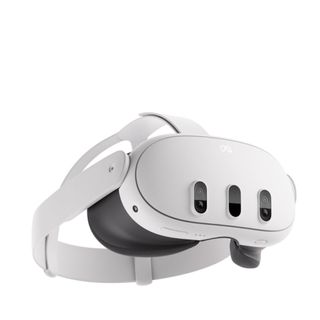
Best overall
The Meta Quest 3 offers both virtual and mixed reality, with twice the Quest 2's graphical power for games and full-color passthrough to your living room.
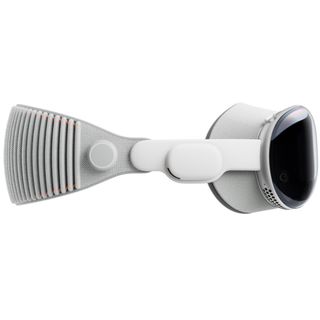
Best premium
Let's say you have cash to spare and want better graphics than the Quest 3 can offer. In that case, the Apple Vision Pro wins the day, with its epic 23 million pixels and powerful M2 performance.
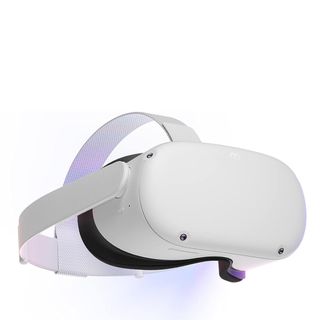
Most affordable
With over 20 million headsets sold, the Quest 2 is the most popular VR headset of all time for a reason, and it's still on sale for hundreds less than the Quest 3.
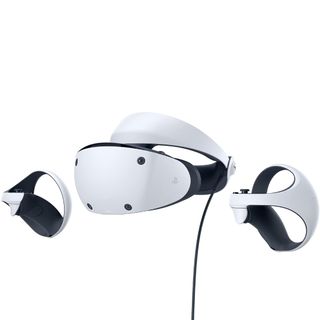
Best graphics
The built-in halo strap, gorgeous OLED display, built-in eye tracking, and the power of the PS5 all set the PSVR 2 apart from Quest headsets, if you can accept the wire.
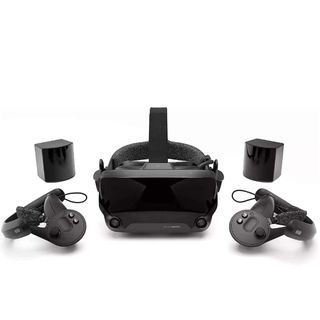
Best for PC VR
Even though it's a few years old, the Valve Index remains popular thanks to its wide and crisp display with ultra-fast 144Hz refresh rate, along with other PC VR perks.
Best overall
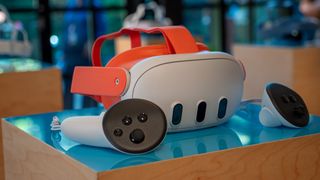
Specifications
Reasons to buy
Reasons to avoid
If we had to recommend one VR headset to buy in 2024, it would be the Meta Quest 3. Why? Because most people today buy VR headsets for gaming, and it's the best option for gaming with its wireless design, revamped graphics and more comfortable balance compared to the Quest 2, and massive library of excellent Quest games.
Our Meta Quest 3 reviewer called this "the best VR headset you can buy" in his review, and the Apple Vision Pro's launch the following year hasn't changed that. It's not that Apple's headset doesn't have massive advantages — our Vision Pro vs. Quest 3 guide shows how it wins with gorgeous visuals and raw power — but that the advantages aren't enough to justify spending an extra three grand. At least not for most people.
Apple may have more apps and the power necessary to work in mixed reality, but most people remain happy enough working in their current reality. Outside of VR power users, the Quest 3 has the games and streaming apps you need, plus the ability to use full-color mixed reality at a respectable 18 PPD if you ever need to check your surroundings mid-session.
As for owners of the best-selling Quest 2, the Quest 3 performs significantly faster, giving developers the ability to patch your current Quest games with more textures, shadows, and assets that the Quest 2 couldn't support. You'll feel much more immersed in your worlds, thanks to the wider FoV, higher resolution, and better IPD adjustment to match your eyes exactly.
Keep in mind that the Quest 3, despite being the best VR headset, doesn't provide a perfect experience. You'll really need some Quest 3 accessories like an Elite Strap for a more comfortable fit than the default cloth strap provides, the 2-hour battery life is on the short side, and you'll miss out on premium perks like eye tracking.
Still, these downsides are fixable, and other headsets just can't compete. Really, your only tough decision is choosing between the Quest 3's 128GB or 512GB storage options!
Best premium

2. Apple Vision Pro
Our expert review:
Specifications
Reasons to buy
Reasons to avoid
The Apple Vision Pro is certainly the most exciting VR headset available today. Apple's entry into the mixed-reality space has brought in a bunch of competing brands, all vying to be the best productivity VR headset. With the Quest Pro defunct and the Quest Pro 2 not ready until 2025, Apple's headset is your best current option.
Apple's headset offers upsides like immersive mixed-reality apps, a gorgeous display, and powerful performance that no other headset has yet matched. It hits an excellent 34 pixels per degree, while the Quest 3 only hits 25 pixels per degree. The 100º field of view is more pedestrian, making the edges of your vision blurrier than you might expect, but the micro-OLED lenses provide some gorgeous colors that make up for it.
Still, it costs $3,500 plus tax, AppleCare+, and lens inserts, making it something that everyday people can't afford. It's truly for specialists and enthusiasts, at least until Apple's rumored second version with a cheaper display becomes available.
Our sister site iMore had hands-on time with the Vision Pro, and it praised the "exceptional" experience of watching 3D movies in-headset, while a spatial video of a child's birthday party was so immersive that it literally brought the author to tears. They also praised the intuitiveness of the gesture controls, which is a relief since the Vision Pro has no dedicated controllers.
On the other hand, a second iMore writer tested the Vision Pro and took a less enthusiastic view. She equated the video experience to an IMAX theater and said the battery pack isn't a big deal if you're using it while sitting. On the other hand, she noted several times how the "heavy" headset design detracted from the immersion, and that the gesture controls didn't always work until after a couple of tries.
The bottom line is that Apple did a fantastic job with its first attempt, but it needs to prove that it can make future Vision headsets more accessible and emphasize VR gaming for the masses before it truly challenges the Quest 3.
Most affordable
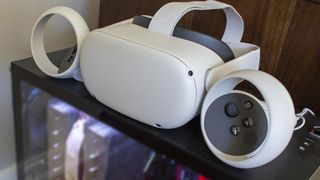
Specifications
Reasons to buy
Reasons to avoid
Like the Quest 3, using an Oculus Quest 2 is as easy as putting the headset on and immediately entering the world of VR. There's no fiddling with settings, no tangling around wires, and no worrying about incompatibilities with the latest games or apps. The controls are intuitive, the Guardian system ensures you don't hurt yourself or break something, and it's great for VR fitness.
All that hasn't changed just because the Quest 3 now does some things better, and it's no surprise that the cheap Quest 2 continues to sell well even after the Quest 3's launch. Your question should be whether you can make do without the newer headset's perks.
The Meta Quest 2 was a significant upgrade over the original Oculus Quest in almost every way. In our Meta Quest 2 review, we detail exactly why, but in a nutshell, the Quest 2 is not just significantly more powerful than its predecessor: It features a 50% higher resolution screen, better speakers, faster Wi-Fi 6 connectivity, and plenty of extras you might not even consider.
Of course, you need only look at our Quest 3 vs. Quest 2 guide to see how the newer headset jumps ahead. The Quest 2 runs on the power equivalent of a 2020 flagship phone; the Quest 3 has the power of a 2023 flagship phone and more RAM. It also has 445 more pixels per inch, 40% louder speakers, and more compact pancake lenses. Of the two, the Quest 2 needs a strap replacement more because of how front-heavy it is.
Despite all this, the Quest 2 remains a remarkable device with a massive library of Quest and App Lab titles, plus the promise of more games for the next few years — since Quest 3 exclusives will be rare. If you can find a refurbished Quest 2 for less than its already-low $299 price, that could be an accessible way to dive into VR without paying for a higher-end Quest 3 or PSVR 2.
Best graphics
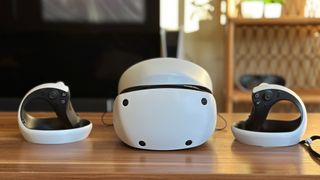
Specifications
Reasons to buy
Reasons to avoid
On paper, the PSVR 2 is an excellent headset that gives the Quest 3 a run for its money, if you already own a PS5 and don't mind a wired experience. In practice, the PSVR 2's post-launch life has disappointed us somewhat, making it a bit harder to recommend this year.
Visually, PS VR2 gives you a 120Hz OLED display with a 110º field of view and a respectable 800 pixels per inch, higher than last-gen headsets like the Quest 2 but well short of the Quest 3 (1,218). The OLED display gives you richer colors than an LCD and hits a smooth 120Hz backed by the PS5's powerful CPU cores, but we do wish its resolution was slightly richer, and the fresnel lenses have a noticeable sweet spot that the Quest 3's pancake lenses lack.
Our PS VR2 review explained that the headset is quite comfortable thanks to the adjustable halo strap, but that the cord from the PS5 draped on the user's back takes some getting used to. We appreciated the button to switch into B&W passthrough mode at the time, but the Quest 3 arriving later that year with full-color passthrough, however, made this latter perk less special.
Directly comparing the PSVR 2 vs. the Quest 3, Sony's headset has the upside of the PS5's raw power, enabling AAA experiences like Horizon Call of the Mountain and VR ports like Resident Evil 8 and Gran Turismo 7. Otherwise, aside from these few exclusives, the PSVR 2 mostly has ports of Quest titles, so the experience isn't that different.
We noted on the PSVR 2's one-year anniversary that the number of exclusives has disappointed us compared to the original PSVR; since then, Sony laid off a number of people from its London and Firesprite studios that had been working on VR titles. That makes us less than enthused about Sony's commitment to the console. Despite that, it's still a very good VR headset with a large library of games, some of which you can't play anywhere else.
Best for PC VR

5. Valve Index
Our expert review:
Specifications
Reasons to buy
Reasons to avoid
We prefer wireless VR headsets wherever possible, especially since the Meta Quest 3 can connect wirelessly to gaming computers for PC VR. Still, if you look at the monthly Steam survey, you'll note that only the Valve Index can compete with Meta for PC VR gaming. That's for a good reason.
The Valve Index came out in 2019, and while some aspects of it are dated, others were ahead of its time. For instance, its field of view and refresh rate trumps what newer headsets offer, and its controllers offer a cool finger-tracking mechanic that other headsets may not offer. While newer headsets rely solely on inside-out tracking, the Valve Index's base station tracking certainly works well enough if you play VR games in one specific space.
You also benefit from direct access to the SteamVR interface, whereas the Quest 3 accesses it through an intermediary app. Games like Half-Life: Alyx are a joy to play, with mechanics that the Quest 3's mobile processor can't handle.
The main downside of the Valve Index is its advanced age. Valve still sells it, but everyone is waiting for a new version (allegedly codenamed "Deckard") that'll have better resolution, plus (allegedly) a wireless design. So while the Valve Index belongs on this list of the best VR headsets, we're not sure we'd recommend buying a new one this year.
How to choose between the best VR headsets
Why you can trust Android Central
Ultimately, the Meta Quest 3 is the best VR headset you can buy, regardless of whether you own a PC or a console, because the Quest 3 doesn't need another device to offer an immersive experience. Even better than the Quest 2, it delivers immersive experiences that feel real, without the wired tether forcing you to remember that you're not actually there.
The PSVR 2 and Valve Index are fully reliant on a PS5 or PC, respectively, and the Apple Vision Pro is meant to be used in tandem with other Apple devices like a MacBook or iPhone. The Quest 3 is its own independent system that doesn't require any extra steps to dive into VR gaming, and that makes it our first choice.
If you want to save some money but still have access to the massive library of Quest games, you can consider waiting for the Quest 3 Lite or buying the Quest 2. Otherwise, since the Quest 4 is still years away, you'll be hard-pressed to find a better gaming option for less than $500.
For now, the best VR headset for productivity is certainly the Apple Vision Pro; maybe your workplace can help pay for some of it. You can also hold out for the Quest Pro 2 or Samsung's unnamed XR headset — possibly called Samsung Glasses — which should have Google's new XR software and Play Store app access.
Be an expert in 5 minutes
Get the latest news from Android Central, your trusted companion in the world of Android

Michael is Android Central's resident expert on fitness tech and wearables, with an enthusiast's love of VR tech on the side. After years freelancing for Techradar, Wareable, Windows Central, Digital Trends, and other sites on a variety of tech topics, AC has given him the chance to really dive into the topics he's passionate about. He's also a semi-reformed Apple-to-Android user who loves D&D, Star Wars, and Lord of the Rings.
For wearables, Michael has tested dozens of smartwatches from Garmin, Fitbit, Samsung, Apple, COROS, Polar, Amazfit, and other brands, and will always focus on recommending the best product over the best brand. He's also completed marathons like NYC, SF, Marine Corps, Big Sur, and California International — though he's still trying to break that 4-hour barrier.
- Danny GallagherFreelance Writer, VR/AR
- Nicholas SutrichSenior Content Producer — Smartphones & VR
